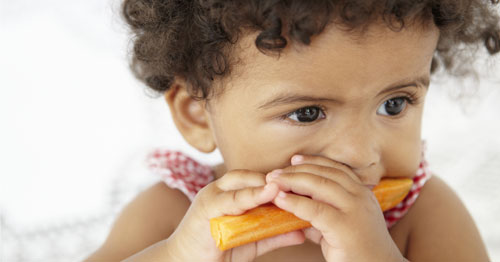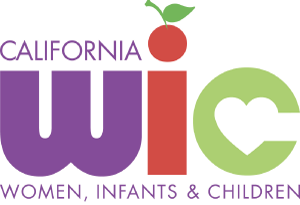
Little by little Your child is eating many different foods. She’s getting better and better at using a small spoon, fork, plate and cup.
Feeding themselves Children want to do things for themselves. They like to do what the adults around them are doing. Your child wants to feed herself, and she can even serve herself from a bowl. Don’t worry if she’s messy!
Children eat less Children need less food than adults. Their bodies are smaller, and their stomachs are smaller. Don’t expect your child to eat as much as you do.
How many meals and snacks? Offer your child food at least 5 times a day. WIC suggests 3 meals each day and snacks in between meals 2 or 3 times each day.
Why snacks? Children get hungry often and need to eat again and again. Give your child healthy foods as snacks.
Your child decides how much Let your child decide how much of each food to eat. If she doesn’t want a food that you offer, let her decide to leave it on her plate. Your child wants to feel full. She will eat as much as she needs.
Start by giving your child a small amount of each food. If she finishes 1 of these foods and wants more, offer her a little bit more.
Young children’s appetites Read more about young children’s appetites and how they eat. Click here>>
You decide which You decide which healthy foods to offer. Your child can eat almost anything you eat. But the pieces need to be bite-sized. And the food needs to be soft enough for her to chew easily.
Everyday Offer your child each kind of food everyday: fruit, vegetables, protein, dairy, and grains.
Healthy, whole foods Feed your child and your entire family a variety of healthy, whole foods:
• fresh fruit
• fresh vegetables
• lean meats
• beans
• low-fat dairy, such as low-fat milk and low-fat yogurt
• grains, such as oatmeal, brown rice and quinoa
Foods–healthy or not? Foods that come in packages often have many ingredients, including chemicals and added sugar. Chemicals and added sugar are not healthy. But you have choices. For example, you can cook meat yourself. That meat will be healthier than hot dogs and deli meats. You can mash your own potatoes. Your potatoes will be healthier than mashed potatoes from a box.
You can tell if a food has chemicals, added sugar or added sodium (salt) by reading the list of ingredients that you’ll find on the box, package or can. Sugar has many names. Read more about added sugar here>>
Grains Brown rice and quinoa are healthy for you and your child and are easy to cook.
Much of the grain we eat is in cereal, tortillas and bread. Some of these foods are healthier than others.
Whole grain Cereal, tortillas and bread are healthier for you and your family when the grain in them is whole grain. One example of this is whole wheat bread. You can tell if a food is “whole grain” by reading the list of ingredients on the box or package. The first item on the list should have the word “whole” in front of it (for example, whole wheat, whole oats, whole rye).
Fruit Offer your child many kinds of fruit, especially those that have vitamin C. Some of these are oranges, strawberries, melons mangos and papayas.
Vegetables Offer your child dark green vegetables and orange vegetables every day. Some dark green vegetables are broccoli, greens and spinach. Some of the orange or yellow vegetables are carrots, sweet potato and squash.
Protein Offer your child foods that contain protein every day. These can be chicken and turkey, especially the dark meat, egg, cooked dry beans, lentils, red meat, tofu and peanut butter. Meat and beans also have the most iron. If your child needs more iron in her blood, eating more beans or red meat is important.
Dairy Offer your child dairy products every day. Some dairy choices are breastmilk, cow’s milk, cheese, cottage cheese, and yogurt. Soymilk is a good substitute for cow’s milk if your child does not eat dairy.
Oils Offer your child foods with oil. The best oils come from plants. Some of these are avocados, olive oil, and canola oil. Adding oil to salads is a healthy way to give your child oil. Deep frying foods in oil is not a healthy way.
Drinks Water is the healthiest drink for you and your child. Offer her water many times during the day.
A little juice is fine. No more than 4-6 ounces in a day. More juice is a problem, because it has so much sugar in it. You can offer your child a little juice, but in fact, she doesn’t need juice.
No soda! Don’t give your child soda! Soda has sugar and chemicals. Soda often causes children and adults to become overweight and even obese. Soda also causes the teeth to rot, and this means she would need dental work.
Read more about added sugar here>>
MyPlate can help! MyPlate helps us find healthy ways to eat. You may have seen the MyPlate picture. It shows us how much of each kind of food to put on our plate.
The MyPlate website is also helpful. You can find it at http://www.choosemyplate.gov.
Read “10 Tips for Healthy Snacking” here>>
Read “Kid-Friendly Veggies and Fruits” here>>
Are you a WIC parent? If you are a WIC parent, your WIC educator will talk to you one-on-one about ways to keep your child healthy.
You can also go to parent sessions. You will meet with other parents and a WIC educator, and learn about feeding your child and how to keep her healthy as she grows.
WIC food checks WIC offers food checks for young children and other family members who are eligible for WIC. These are checks for buying healthy foods. Read more about WIC food checks here>>


